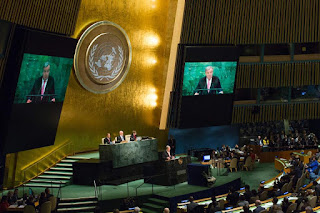New Light On Iran's Human Rights Violations
SEP 4, 2017
BY:Heshmat Alavi
Two of the major crises the international community is currently engaged with are terrorism and nuclear proliferation. Iran, in particular, is negatively involved in both fields, being known as the central banker of international terrorism, and suspicious for its own controversial nuclear program at home parallel to its nuclear/missile collaboration with North Korea.
 As these subjects are of significant importance and deserve even more attributed attention, what must not go neglected is the fact that Iran is taking advantage of such circumstances to continue an equally important campaign of belligerence against its own people. The scope of human rights violations carried out by Tehran is continuously on the rise, with the ruling regime interpreting the mentioned international crises as windows of opportunity to extend its domestic crackdown.
As these subjects are of significant importance and deserve even more attributed attention, what must not go neglected is the fact that Iran is taking advantage of such circumstances to continue an equally important campaign of belligerence against its own people. The scope of human rights violations carried out by Tehran is continuously on the rise, with the ruling regime interpreting the mentioned international crises as windows of opportunity to extend its domestic crackdown. And yet, a promising report issued from the United Nations has shed very necessary light on a specific dossier Iran has gone the limits throughout the past three decades to cloak. In 1988 the Iranian regime carried out an atrocious massacre sending tens of thousands of political prisoners to the gallows. Unfortunately, the world has until recently remained silent in this regard.
And yet, a promising report issued from the United Nations has shed very necessary light on a specific dossier Iran has gone the limits throughout the past three decades to cloak. In 1988 the Iranian regime carried out an atrocious massacre sending tens of thousands of political prisoners to the gallows. Unfortunately, the world has until recently remained silent in this regard.
Twenty nine years after the atrocious carnage, Asma Jahangir, the UN Special Rapporteur on the situation of human rights in Iran, issued a report on September 2nd for the first time referring to the massacre of over 30,000 political prisoners, mostly members and supporters of the Iranian opposition People's Mojahedin Organization of Iran (PMOI/MEK).
This document, coupled with a note by UN Secretary-General Antonio Guterres and presented to the UN General Assembly, has for the first time specifically attributed a number of articles to the 1988 massacre. Thousands of men, women and juveniles were sent to the gallows, and buried in mass, unmarked graves, all according to a fatwa, or decree, issued by the deceased Iranian regime founder Ayatollah Khomeini.
Raising the stakes to a level Tehran has sought to avoid through the years, this damning UN report has called for an independent and thorough inquiry into these crimes to unearth the truth of the atrocities carried out in the summer of 1988.
 Activists and the Iranian Diaspora have for 29 years focused their measures on presenting evidence of the killings. This has finally been acknowledged in this UN report.
Activists and the Iranian Diaspora have for 29 years focused their measures on presenting evidence of the killings. This has finally been acknowledged in this UN report. “Between July and August 1988, thousands of political prisoners, men, women and teen-agers, were reportedly executed pursuant to a fatwa issued by the then Supreme Leader, Ayatollah Khomeini. A three-man commission was reportedly created with a view to determining who should be executed. The bodies of the victims were reportedly buried in unmarked graves and their families never informed of their whereabouts. These events, known as the 1988 massacres, have never been officially acknowledged. In January 1989, the Special Representative of the Commission on Human Rights on the situation of human rights in the Islamic Republic of Iran, Reynaldo Galindo Pohl, expressed concern over the “global denial” of the executions and called on Iranian authorities to conduct an investigation. Such an investigation has yet to be undertaken.”
“Between July and August 1988, thousands of political prisoners, men, women and teen-agers, were reportedly executed pursuant to a fatwa issued by the then Supreme Leader, Ayatollah Khomeini. A three-man commission was reportedly created with a view to determining who should be executed. The bodies of the victims were reportedly buried in unmarked graves and their families never informed of their whereabouts. These events, known as the 1988 massacres, have never been officially acknowledged. In January 1989, the Special Representative of the Commission on Human Rights on the situation of human rights in the Islamic Republic of Iran, Reynaldo Galindo Pohl, expressed concern over the “global denial” of the executions and called on Iranian authorities to conduct an investigation. Such an investigation has yet to be undertaken.”
The atrocities, of such grave nature, rendered a major rift amongst the regime’s leadership and highest authorities. The late Ayatollah Hossein-Ali Montazeri, then Khomeini’s designated successor, expressed his opposition to the killings and the massacre came back to haunt a presidential hopeful in the most recent such election held back in May.
“In August 2016, an audio recording of a meeting held in 1988 between high-level State officials and clerics was published.
The recording revealed the names of the officials who had carried out and defended the executions, including the current Minister of Justice, a current high court judge, and the head of one of the largest religious foundations in the country and candidate in the May presidential elections. Following the publication of the audio recording, some clerical authorities and the chief of the judiciary admitted that the executions had taken place and, in some instances, defended them.”



Comments
Post a Comment